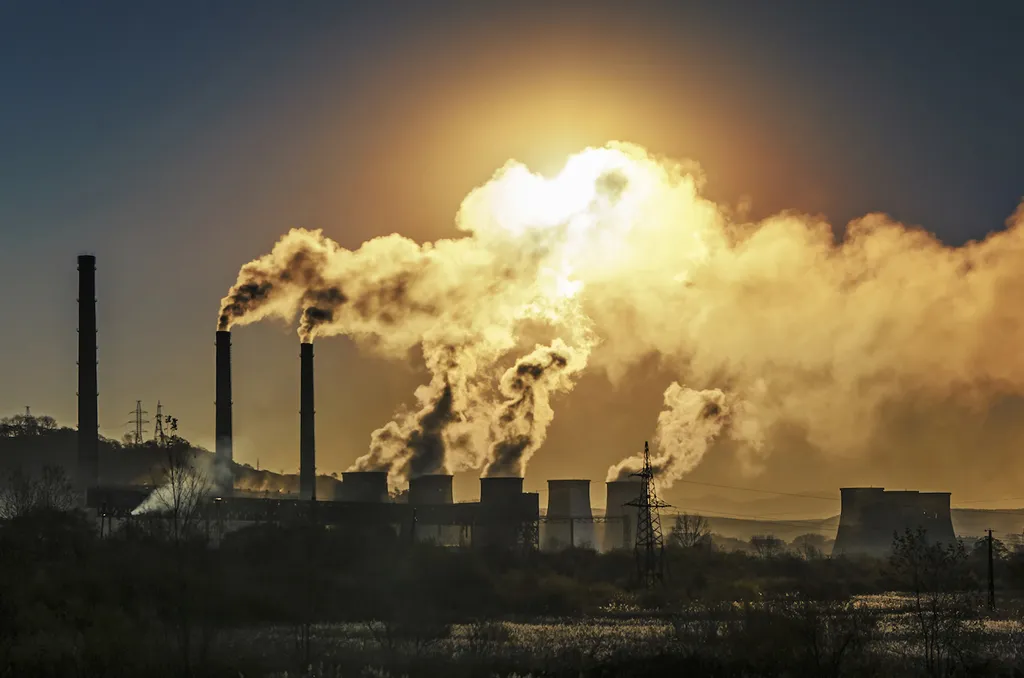This is a legacy page of a global environmental governance class.
The Paso del Norte Air Basin: opportunity and reward in a chronically polluted region
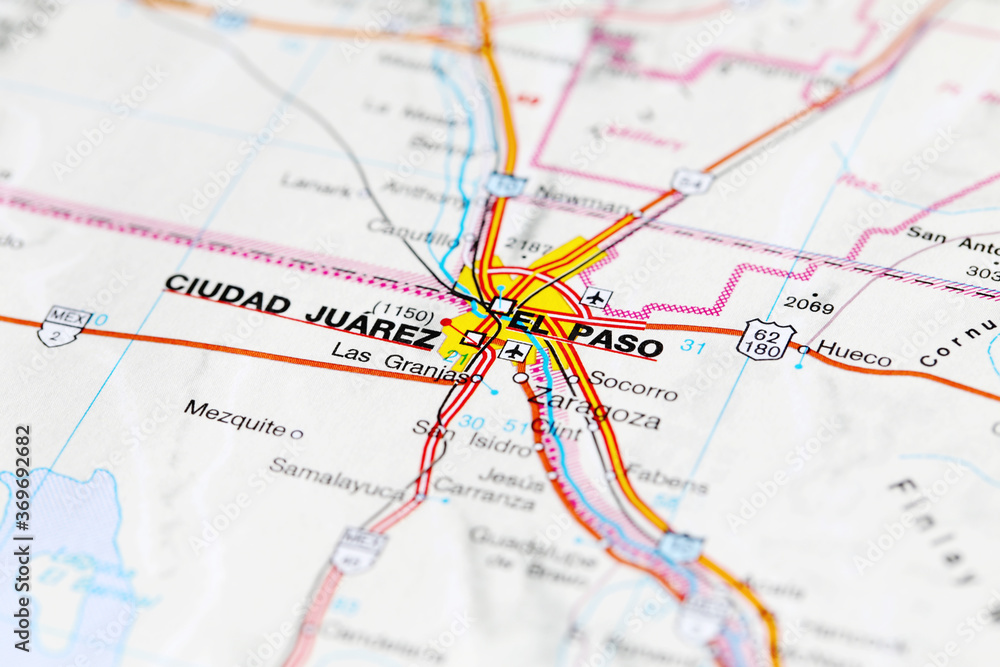
The Paso del Norte Basin (the Basin), comprising El Paso, TX, Sunland Park, NM and Ciudad Juarez, Chihuahua, suffers from some of the worst air quality across the United States and Mexico- ranked as the 14th worst urban air quality in the United States in a 2023 report by the American Lung Association. Development of the Basin began in the 19th century when it became recognized as one of the lowest passage points along the continental divide. Mining, smelting, agricultural and manufacturing industries gathered along either side of the border over the next two centuries and the surrounding urban area grew in kind to meet the need for a growing labor force. Today, the Basin remains a hub for industrial manufacturing.
With an urban area of over 2.7 million, the Basin is the second-largest transborder agglomeration along the U.S.-Mexico border and hosts the third largest inland port of entry between the U.S. and Mexico, behind Laredo, TX and San Ysidro, NM. In 2018 alone, the El Paso border crossing handled over 2,000,000 and 844,000 northbound crossings of cars and trucks, respectively. Cars and trucks are the largest contributors to air pollution within the Basin. Additional polluters such as scrap tire fires and wood-stove cooking are known to contribute to poor regional air quality, however the exact relative contributions remain unclear.
Manufacturing within El Paso county alone accounts for 8.3% of the economy of Texas, bringing in an estimated $2.7 billion dollars. Petroleum and coal, primary metal, and apparel are all considered as strong industries within the region and still growing. Ciudad Juarez itself has over 320 factories, accounting for more than 60% of factory jobs in the state of Chihuahua. Coupling these numbers with a growth rate of 5% and 1.38% for El Paso and Ciudad Juarez, respectively, air quality issues caused by industry manufacturing and traffic will be exacerbated by continued growth in the coming years.
Addressing the rising demand for clean air within the Paso del Norte Basin requires joint efforts by key stakeholders to offer proactive solutions. Closing the information gap on air quality point sources, facilitating binational collaboration towards reducing traffic-related emissions, and encouraging the involvement of private actors will all be necessary to change the trajectory of air quality within the basin.
State Solutions: collaborative approaches

Create a Clean Air Fund
The U.S. and Mexico should establish a “Clean Air Fund” to promote data collection and pollution mitigation initiatives. We recommend that the fund be administered through the North American Development Bank and used for the benefit of the El Paso-Ciudad Juarez region. By issuing grants and loans to private actors and community groups dedicated to cleaning up the region’s air, this initiative would yield numerous benefits. First, by helping defray the costs of air quality monitors, it would improve data availability and increase scientists’ understanding of the causes and consequences of the issue. Second, through funding innovative projects, it would contribute to improving air quality. Third, it would foster collaboration between private actors and communities, enhancing local capacity for environmental stewardship. This complements the top-down regulatory strategy that we also recommend. Finally, it would improve public health by reducing pollution-related illnesses, alleviating some burden on healthcare systems in both countries. Most importantly, we believe this initiative would bolster bilateral cooperation, strengthen diplomatic ties between the U.S. and Mexico. While initial costs of the fund may raise concerns among budget hawks, the long-term economic and environmental benefits far outweigh the financial cost. Through transparent governance and robust accountability measures overseen by the development bank, any potential downsides, such as misuse of funds or lack of efficacy, can be addressed. Overall, the establishment of a Clean Air Fund represents a proactive and beneficial step towards ensuring a healthier and more sustainable future for the El Paso-Ciudad Juarez region and beyond.
Reduce Vehicle Emissions
Idling times at the border crossing are too long and harm air quality. Currently, the setup requires commercial vehicles to wait in long lines to cross the border, often undergoing inspections by customs and border patrol agents. This waiting period prompts drivers to idle their vehicles and run air conditioning, releasing emissions for no added productivity. It is imperative that both states implement regulations to curb idling among commercial vehicles waiting at the border. However, for regulations to effectively address the issue, both countries must also explore innovative alternatives. For instance, this could involve finding alternative routes to redirect commercial traffic away from congested border points, thereby minimizing idling times and redirecting emissions out of the Basin. Additionally, investing in technological solutions through partnerships with private entities to expedite vehicle inspections would prove beneficial. Creative solutions such as electric shuttles that transport trucks across the border without idling offer other promising avenues for reducing air pollution. By embracing innovation and fostering cooperation, we can overhaul border management practices and pave the way for cleaner, healthier air.
Community Organization as a Driving Force
To promote the policies in this post, the communities of El Paso, Sunland Park, and Ciudad Juarez should organize to advocate for policies to improve air quality – either the policies above, or policies that they personally support. The timing couldn’t be more perfect. The U.S. Federal Government is currently considering a renovation project for the Bridge of the Americas (the one toll free bridge between El Paso and Ciudad Juarez).
The traffic from this bridge causes a massive amount of pollution in the region. Cars can idle for up to ten hours at a time waiting to cross the border, releasing huge amounts of vehicle emissions into the cities and neighborhoods around them. This can cause breathing problems for sensitive groups, especially children. Some residents say that the amount of vehicles should be limited, or that commercial vehicles shouldn’t be allowed to use the bridge at all.
“It’s time for us to really look at what’s happening and really call out these entities to do something about it”
Hilda Villegas, La Mujer Obrera
While the GSA (General Services Administration) is currently finished taking comments for this round of design drafting, you can stay up to date on the status of the progress here. You can also contact your local representative to give your thoughts on the project, or on air pollution in the basin as a whole.
- El Paso: Texas 16th Congressional District: Veronica Escobar
- Sunland Park: New Mexico’s 2nd Congressional District: Gabe Vasquez
Low-Cost Air Sensors as a community and industry-based solution

Continuous Air Monitoring Stations (CAMS) currently used by the U.S. EPA are the best in the business in terms of reliability of data, however the price is prohibitive for most communities, with stations costing as much as $250,000 a piece. While CAMS offer long-term reliability of data, their cost and size of the set-up limits the number of stations that can be installed across a city. One of the major issues limiting improvements to air quality in the Paso del Norte air basin is the lack of consistent and reliable air quality data. CAMS are limited in their ability to identify point-source location of air pollution, and to identify those communities suffering the worst.
Low-Cost Air Sensors offer an accessible alternative for communities to empower themselves through widespread self-monitoring. Previous research in the air basin installed a system of Purple Air sensors to create a reliable network of smaller scale monitors across both El Paso and Ciudad Juarez. The initial rounds of research were informative, however one of the major limitations of the Purple Air sensors is their reliance on active connections to a power source and to an ethernet internet service. To improve air quality monitoring across the basin and to improve our ability to identify point-sources, a more reliable and self-sufficient model is necessary. At $1000 per unit, the Clarity air sensors such as the one pictured above, provide 24/7 air quality monitoring using self-sufficient systems that run using solar power and satellite internet connection. Lastly, data is uploaded real-time to an online dashboard that can be made publicly available- allowing members of the community to identify in real-time the quality of the air they are breathing. Set up of the Clarity sensors just requires a surface with ample sunlight to be mounted and occasional cleanings of their solar panels.
The Joint Advisory Committee
As the primary intergovernmental organization working on Basin air quality, we highly recommend the Joint Advisory Committee increase investment in the installation of Clarity sensors across the Paso del Norte Air Basin to provide active and real-time air quality monitoring data. Communities across the Basin have the ability to contribute to the collection of data on air quality to lead to problem-specific approaches to solving air quality issues. Similarly, communities have a right to consistent and reliable information regarding the quality of air they breathe in their own community. Low-cost air sensors such as the Clarity sensors empower communities to become powerful stakeholders in the improvement of their own air quality.
We suggest the following two methods:
- The creation of the “Blue Seal”: An award to recognize industry partners sponsoring a low-cost sensor
- Utilizing the Binational Air Quality Fund to sponsor low-cost sensor installation in low-income communities.
Deforestation in the Brazilian Amazon & the Role of Carbon Markets
The Amazon Rainforest is an invaluable resource not only to Brazil, but to the world as one of the planet’s major carbon sinks. However, in recent years, rapid deforestation poses a major threat to the Amazon and its climate-stabilizing abilities.
Can carbon markets help to address the issue of deforestation in the Amazon?

The Amazon
- Resources
- “Lungs of the Earth:” the Amazon is produces 20% of oxygen generated from land-based photosynthesis (Source)
- It is home to 400-500 indigenous tribes. (Source)
- The Amazon generates an estimated US$317 billion at least annually, (Source)
- and contributes to approximately 10% of Brazils GDP. (Source)
- Its wildlife has immense research and medical value. (Source)
- Biodiversity
- The Amazon is home to:
- 40,000 plant species,
- 3,000 fish species,
- 1,300 bird species,
- 430 mammal species
- 2.5 million insect species
- Many endangered of which are endangered
- (Source)
- Climate
- Carbon Sink: The Amazon currently takes in and stores more than 150 billion [metric] tons of carbon. (Source)
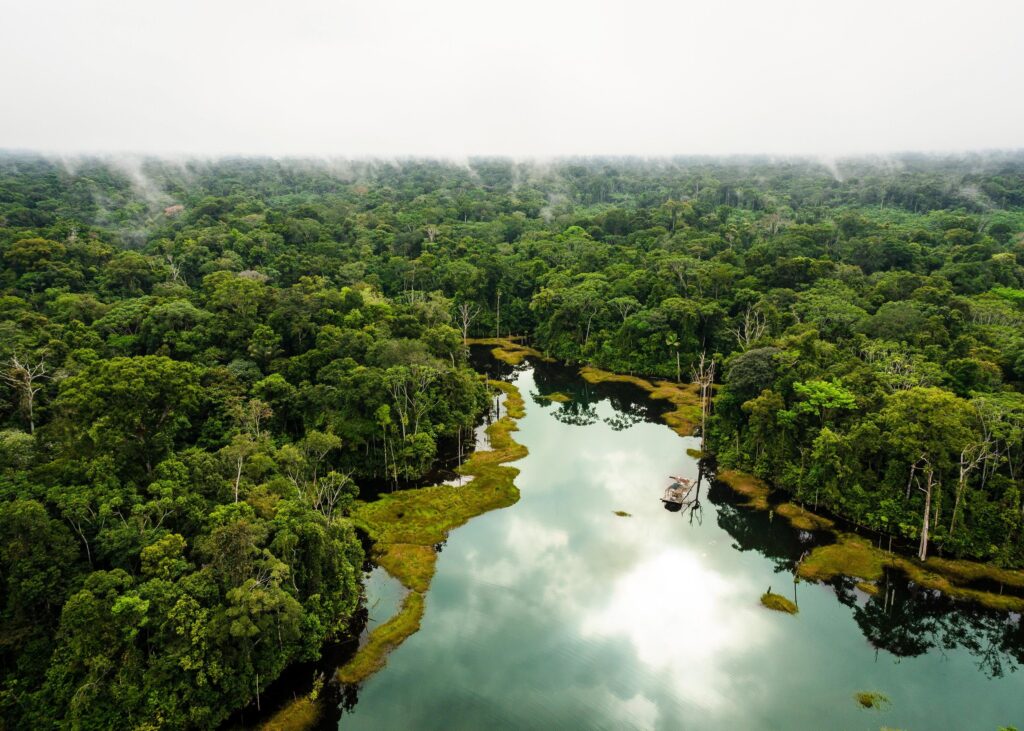


Deforestation
“Over the past 40 years, 20% of the Amazon Rainforest has already been cut down”
One Tree Planted
- The leading driver of deforestation both globally and in Brazil is cattle ranching. (Source)
- Almost all deforestation in the Amazon is unlawful, resulting from illegal ranching, mining, and logging. (Source)
- Deforestation increased under the administration of former Brazilian President Jair Bolsonaro, which cut resources for environmental protection. (Source)
Luiz Inácio Lula da Silva & Brazilian government restore pledge to “halt deforestation completely by 2028.”
Financial Times
Deforestation also generates emissions…
- Brazil is the 5th largest emitter of CO2 in the world
- Deforestation and agriculture account for 70% of Brazil’s emissions.
- 50% of emissions come from deforestation alone.
- (Source)

This means to meet Brazil’s Nationally Determined Contributions (NDCs) of a 37% reduction of CO2 emissions by 2025, and a 43% reduction by 2030, Brazil must focus on reducing deforestation.
“Brazil’s President Luiz Inácio Lula da Silva has said he will do ‘whatever it takes to have zero deforestation.’”
Financial Times
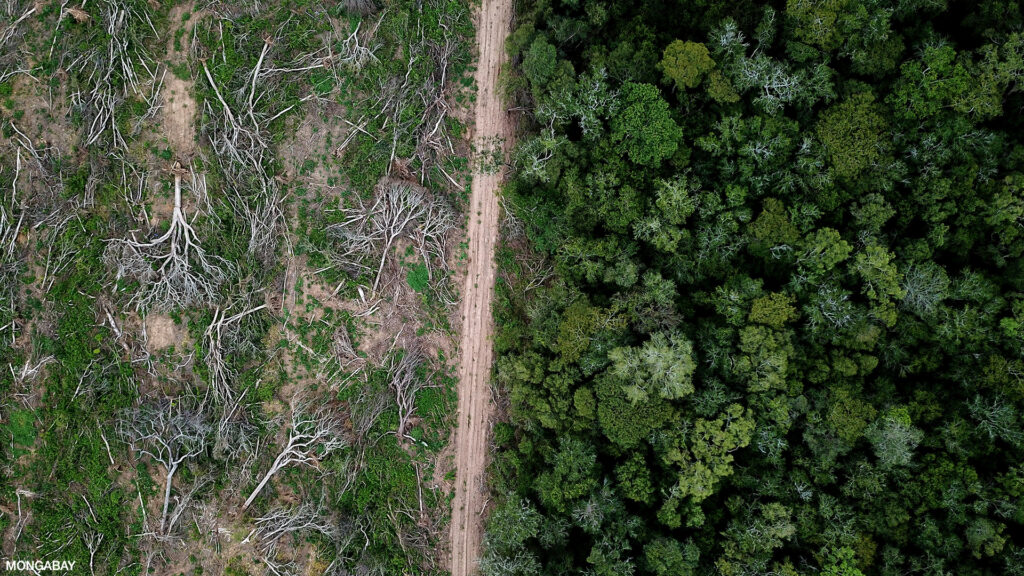


Carbon Markets
To help address this issue, Brazil could turn to carbon markets.
How Do Carbon Markets Work?
- Creating Credits: Projects that reduce CO2 would earn tradable permits/credits/offsets.
- Forests & Credits: Projects that focus on reforestation, forest protection, etc. could sell credits since they reduce carbon by maintaining a carbon sink and reducing carbon released from deforestation.
- Creating Demand for Projects: Polluters who cannot meet emissions goals must purchase offsets, generating demand for these carbon credits. By allowing beneficial forest projects to generate credits, demand for projects that focus on forest protection and/or rehabilitation is also generated.
Recently, lawmakers in Brazil have introduced legislation that would establish a national cap-and-trade system, in which the government would set a “cap,” or “upper limit,” to the amount of CO2 emissions an entity could produce. If entities cannot reduce their emissions to this amount, they will need to purchase carbon permits/credits/offsets. (Source)
Brazil hopes that by tapping into both compliance carbon markets, and voluntary carbon markets (VCM), an estimated $120bn could be brought to Brazil’s economy. (Source)
Potential Problems
- Greenwashing: Skepticism has emerged around carbon credits, as recent reporting has shown that projects often do not generate the benefits they claim to. Studies have shown that only between 10% to 30% of credits traded on the Voluntary Carbon Market are delivering their claimed impact. (Source)
- Agriculture Exemptions: Concerns have also emerged around Brazil’s proposed cap-and-trade system due to exemptions made for agriculture; one of the leading drivers of deforestation and one of the largest sources of CO2 emissions in Brazil. (Source)
Here is how various actors can address this issue:
States: Brazilian Government
- Establish Cap-and-Trade system
- Establishing a compliance market will force polluters who cannot meet emissions targets to buy credits, driving demand for positive forest projects that generate credits.
- Create and enforce standards and regulations around Forest projects
- The Brazilian government would tightly regulate which projects take place and where, and should continue to work to enforce environmental protections.
- Work with IOs & Private Actors to ensure quality of credits
- Governments can help identify areas of priority for projects, and should work with private actors and IOs in establishing proper verification measures.
- Continue setting national goals related to Forest and Climate
- Setting goals like halting deforestation and NDCs drive national policies that promote forest protection.
- Explore other non-market options; such as Indigenous land tenure
- Indigenous land tenure has shown to be effective in increasing forest cover. The Brazilian government should work to promote policies that award Indigenous communities land tenure in the Amazon.
Private Actors
- Demand side offset buyers should purchase offsets strictly from projects using advanced baseline calculation methodologies such as…
- “Dynamic baseline,” which uses new technologies such as remote sensing, high-resolution satellite imagery, machine learning, LiDAR, artificial intelligence and real-time data transmission to improve project monitoring
- Jurisdiction REDD+, which represents a new generation of forestry projects that uses jurisdictional forestry data to issue credits in ways that help prevent leakage
International Organizations: UNEP
- Set a common standard for evaluating and monitoring carbon credits.
- Work with communities and states to discover new opportunities to prevent deforestation.
- Facilitate transfers of carbon credits between states and private actors.
- Become a global, central authority on carbon credits to ensure long run validity.
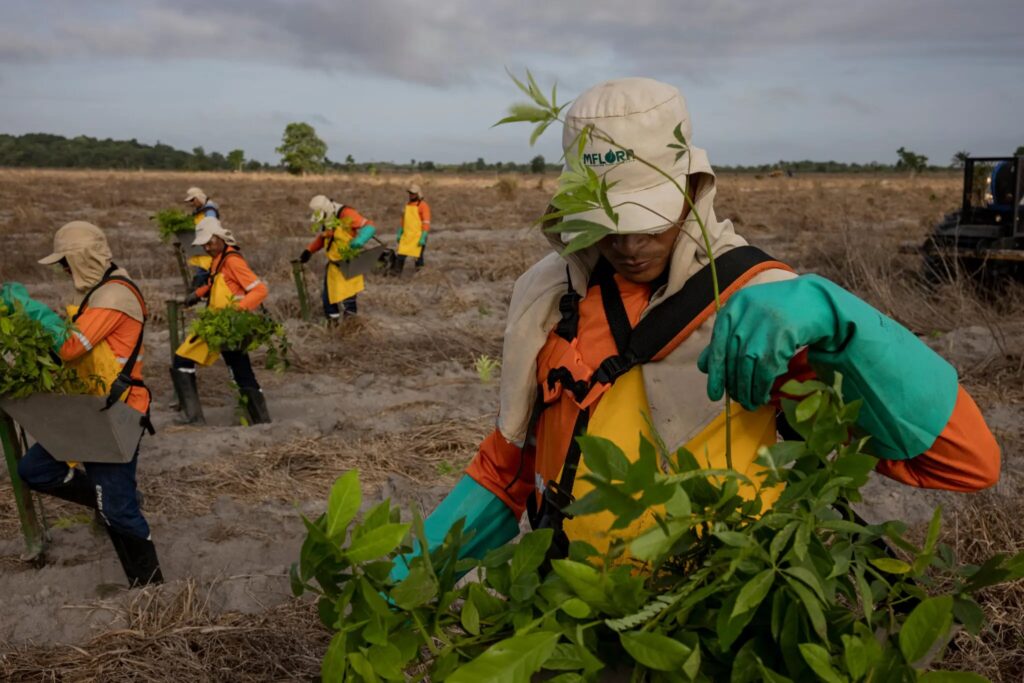
Conclusion
The market for carbon credits in its current state is not going to achieve the goals we would like to see regarding deforestation unless it undergoes significant changes. However, steps can be taken to address this issue. States can continue setting national goals on deforestation, establish a cap and trade system, enforce standards related to deforestation, and work with IOs and local communities to identify priority conservation/reforestation areas. Additionally, Brazil can explore non-market options, such as Indigenous land tenure which has shown to effectively increase forest cover. International Organizations can become a central authority on carbon credits by setting a common standard, facilitating trades/transfers of credits, and working with states and locals to ensure credits are only being created based on at-risk areas. Private actors can come together to set industry standards, such as purchasing offsets strictly from projects using advanced baseline calculation methodologies. Alternatively, private actors can contribute to an international climate finance fund, such as the Green Climate Fund, to help developing tropical nations reach their nationally determined contributions.
Learn More:
Recent news:
- The Financial Times: Brazil to launch regulated carbon market
- The New York Times: Can Forests Be More Profitable Than Beef?
Posted on May 6, 2024 by: Brandon Mulder, Cody Steverson & Kate McCarroll
Four Strategies to Advance Equitable Climate Finance in the Developing World
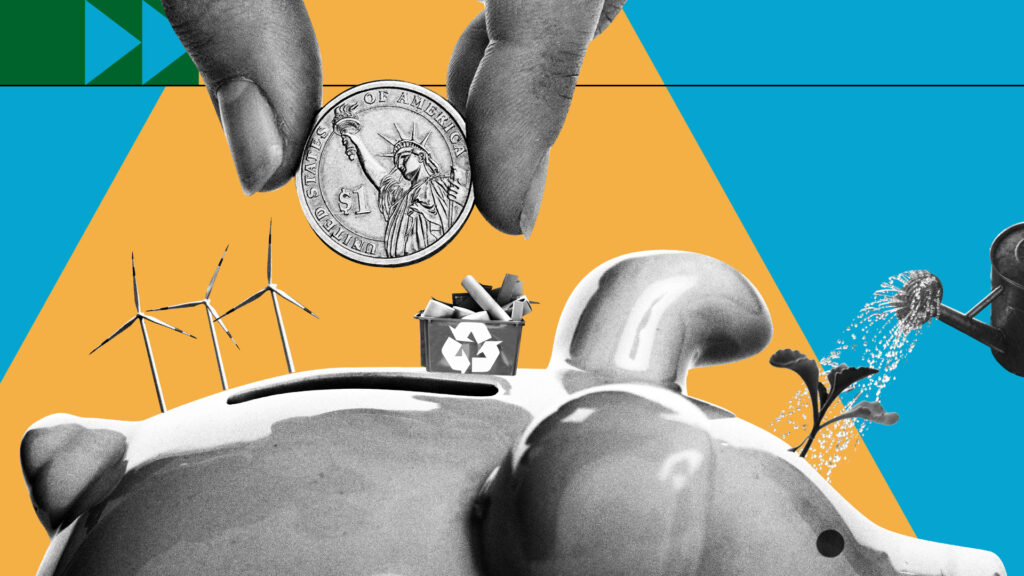
Intersection of Climate and Finance
It is common knowledge that climate change leads to extreme weather patterns, which create a variety of problems in communities around the world as they work to recover from increasingly frequent tropical storms, droughts, flood events, wildfires, and other climate-related shocks. In addition to the lives and communities affected, these events also cause negative financial consequences for governments and private industries. To avoid long-term reactive measures, governments and private industries should invest in climate action efforts. The International Renewable Energy Agency (IRENA) projects that to achieve the 1.5 degrees Celsius global warming scenario outlined in the Paris Agreement, $5.7 trillion USD in yearly investments are needed in the global energy transition. With the inclusion of hundreds of billions of dollars toward modernizing the US energy system in legislation such as the Infrastructure Investments and Jobs Act of 2021 and Inflation Reduction Act of 2022, the United States and many other developed countries have already begun their clean energy transition.
Developing countries, on the other hand, face many obstacles in the realm of climate finance, both in terms of mitigation and adaptation measures. At the UNFCCC’s 15th Conference of Parties in 2009, developed countries agreed to a collective goal of mobilizing $100 billion USD per year by 2020 for climate action in developing countries. However, this goal has not been met, with developed countries only committing $89.6 billion USD in financing for climate action in developing countries in 2021. In addition to falling short of the UNFCCC goal, the vast majority of these funds flowed to middle-income countries, leaving countries with high climate vulnerability and poverty with just a fraction of the available funds for climate mitigation and adaptation needs. Several think tanks estimate that the cost of climate adaptation, which is the primary priority in developing countries, will be closer to $300 billion by 2030, rising to $500 billion by 2050. Significant investments are urgently needed in the developing world to help advance the adoption of clean energy technologies and other climate mitigation and adaptation strategies. The following memo discusses possible approaches that can be taken by state actors, international organizations, NGOs, and private industries around financing global climate action, and highlights some critical gaps and recommendations for future progress.
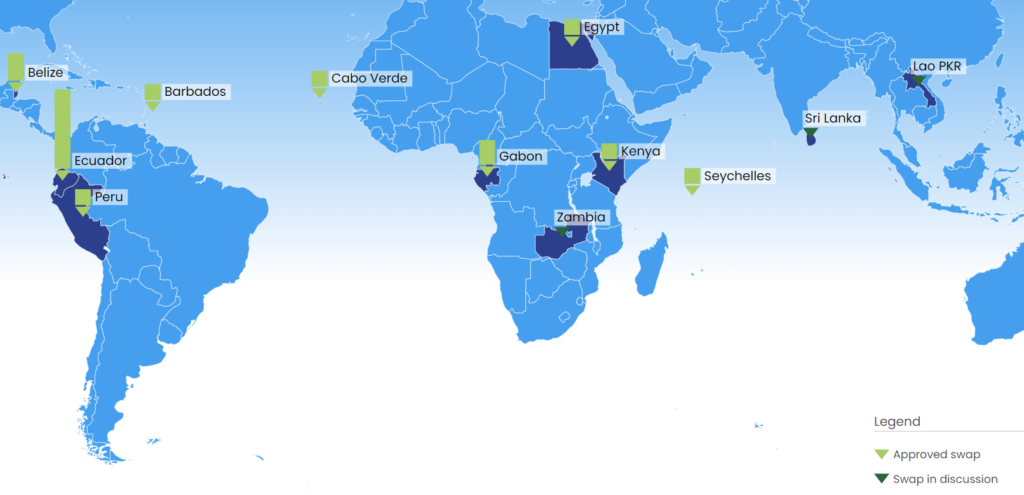
Strategy #1: States should alleviate debt burdens in the developing world by engaging in bilateral debt-for-climate swaps.
Foreign aid for climate action does not finance the full extent of countries’ adaptation and mitigation activities, creating the need for debt financing for many climate projects. According to the OECD, the majority of climate adaptation efforts are financed using debt, with this shift becoming even more prominent in the last few years. This means that countries, primarily in the developing world, are taking on more debt to adapt to the impacts of climate change. Debt-for-climate swaps, which are financial instruments that allow countries to forgive or refinance outstanding debt with other countries, allow developing countries to use debt service savings to finance climate action. Debt-for-climate swaps can alleviate debt burdens in the developing world while still allowing lower-income countries to advance their climate mitigation and adaptation goals.
Benefits:
- Debt-for-climate swaps allow developing countries to invest in climate mitigation and adaptation measures while reducing their debt burden.
- Bilateral agreements to cancel or refinance debt can provide dedicated funding for climate action, with debtor countries committing to use savings for specific climate-related projects.
Strategy #2: Policy think tanks and research organizations can engage in more elite advocacy.
Think tanks and research organizations across the world can engage in more elite advocacy with powerful decision-makers in the countries they work in and private corporations whose values align with this mission. The influence of these institutions in donor states can increase political will to achieve major climate finance goals. Moreover, the nature of climate adaptation investments makes them risky and have low return on investment. To overcome this, ESG and climate-aligned companies can be encouraged to make private dollars available through philanthropy and low-interest loans available for climate finance.
Benefits:
- Successful advocacy will increase the pool of money available for developing countries which is the overall goal.
- The donation of private dollars will not increase the debt burden of developing countries.
- Models that use these mechanisms and ideas already exist.

Strategy #3: Create a global market for energy equipment leases and physical power purchase agreements (PPA’s).
As described by the EPA, energy equipment leases are essentially public-private partnerships which allow for private consumers and organizations to stretch the payment for large clean energy investments over several years. When the equipment lease ends, the customer may purchase or return the equipment (ex. high-efficiency HVAC systems or solar panels) or extend the contract, depending on the type of lease. Leases may be provided by state or local governments or third-party/private companies. One example similar to this is the Scaling Solar program implemented by groups within the World Bank for scaling solar power in African countries.
Benefits:
- Equipment leases and PPAs could allow low-income individuals and/or developing countries to commit to the clean energy transition which in other cases, may not be available or affordable.
- Energy equipment leasing partnerships and PPAs could also boost green workforce development in both developed and developing nations.
- Multiple lease options are available, including operating, capital, and municipal leases.
Strategy #4: International organizations should secure funds for developing nations to aid them in their climate change mitigation efforts.
International organizations must oversee the routing of funds from developed economies towards developing ones to bridge the capacity gap between the two and aid the latter in their climate change mitigation efforts. International organizations are to establish transparent and standardized accounting practices for climate finance to address the ambiguity and lack of transparency in defining international climate and clean energy finance. Additionally, they must advocate for initiatives that aim to increase capital flows to developing countries for the clean energy transition, ensuring that financing is accessible to a broader range of countries and projects beyond the current limited scope. Moreover, international organizations could promote the development of risk mitigation mechanisms and financial instruments to address perceived risks associated with investing in emerging markets, thereby attracting more private capital to clean energy projects in these regions.
Benefits:
- Support bridging the capacity gap between developed and developing countries by providing financial resources to the latter for climate change mitigation efforts.
- Transparent and standardized accounting practices increase accountability and trust in the management and use of climate finance, reducing the risk of corruption and mismanagement.
- Effective risk mitigation attracts more private sector engagement in climate projects, leveraging additional resources and expertise to scale up clean energy initiatives.
The Bottom Line
With the impacts of climate change increasingly affecting vulnerable populations around the world, the urgency of climate action for developing countries highlights the need for timely financing solutions. By employing these strategies, the states, international organizations, and NGOs can foster pathways toward the 1.5 degree Celsius global warming scenario set out in the Paris Agreement, facilitating regional and bilateral agreements among high-emitting developed countries and highly vulnerable developing countries.
Tourism: A Double-Edged Sword for Coral Reef Conservation
Over-tourism is both part of the problem and the solution.

Coral reef bleaching episodes have increased in frequency and intensity over the last few decades, and projections indicate that live coral reefs could decline by 70-90% by 2050 without drastic action to limit global warming to 1.5°C. Coral reefs are among the most biodiverse and economically significant ecosystems on earth, and their preservation is essential. When corals become stressed due to higher ocean temperatures, pollution, or some other stressor, they expel symbiotic zooxanthellae, which removes their color and increases their susceptibility to disease and death.
While climate change and overfishing are significant contributors to the coral reef bleaching crisis, attempts to reach an international consensus regarding such topics have failed. However, the tourism industry, also to blame but often overlooked, has the unique opportunity to influence reef management and conservation practices from the bottom up.
With a staggering 70 million people flocking to coral reefs each year, coastal tourism, accounting for 85% of global tourism, has placed immense pressure on these fragile ecosystems. The demand for reef tourism is reflected in the economic footprint of on-reef and adjacent-reef tourism, amounting to about $19 billion and $16 billion each year, as depicted in the graph above. Unfortunately, the repercussions of over-tourism are severe, exacerbating reef vulnerability to bleaching and other environmental stressors. Moreover, it poses a long-term threat to the health of these ecosystems and the communities that depend on them, underscoring the urgent need for sustainable tourism practices.
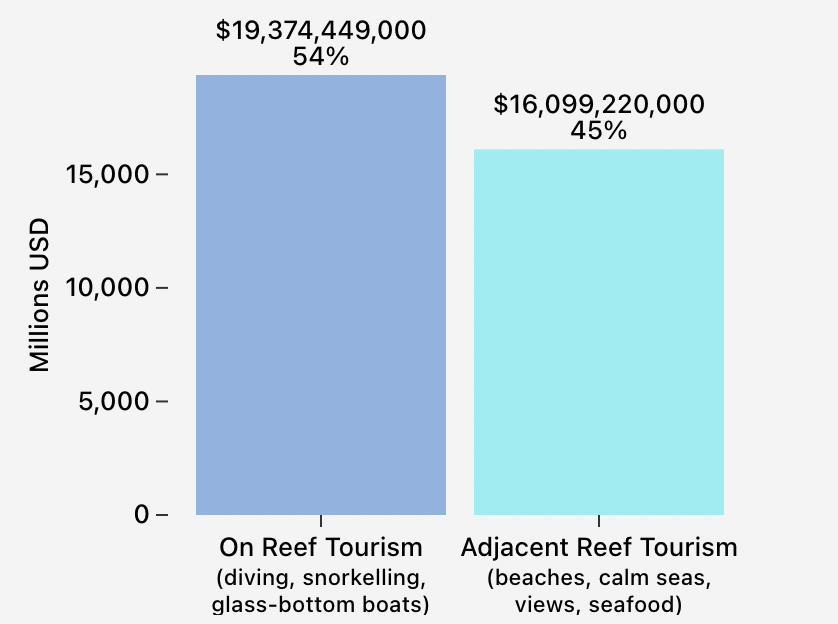
Over-tourism harms coral reefs.
One major concern is direct physical damage. Even well-meaning snorkelers and divers can accidentally bump into coral with their fins or struggle with buoyancy control, causing breakage. Additionally, recreational boats can leave a devastating footprint. Their anchors scrape and break fragile coral structures, leaving lasting scars on the reef.
Beyond physical harm, chemical pollution poses a serious threat. Sunscreens containing chemicals like oxybenzone and octinoxate wash into the ocean as tourists swim. These chemicals disrupt coral growth and reproduction, weakening the very ecosystems we come to admire. Reef-safe sunscreens help to combat the problem because they are made with less harmful ingredients, but very few know about this problem and even fewer are incentivized by government interventions to make the switch. Improper waste disposal and inadequate sewage treatment further compound the problem. This influx of pollutants smothers corals and disrupts the delicate balance of the reef’s ecosystem.
The tourism boom also drives unregulated coastal development to accommodate hotels, restaurants, and infrastructure. This development, in turn, leads to increased sedimentation. Sediment runoff chokes coral, blocking sunlight penetration, a vital source of energy for these organisms. Deforestation to clear land for development further exacerbates erosion and sedimentation problems.
Well-managed ecotourism could actually benefit coral reefs.
However, there’s a silver lining. Tourism doesn’t have to be a one-way street of destruction. By adopting sustainable practices, tourists can become eco-warriors and contribute to reef conservation efforts. One way to do this is by supporting eco-friendly tour operators. These responsible businesses prioritize reef-safe diving practices and use mooring systems instead of anchors, protecting reefs from major physical damages. Tourism businesses also have the unique opportunity to educate tourists on proper reef etiquette and limit the number of people near the reefs at a time to minimize crowding and associated stress. Tourists may even be asked by their diving or snorkeling guides to use reef-safe sunscreen.
Tourism and fishing businesses also have the opportunity to influence behavior and contribute to the preservation of their ecosystems directly through reef restoration projects. Coral rehabilitation, larval seeding, and coral transplantation allow locals and tourists alike to participate in reef preservation, while still being able to enjoy the scenic views and ecosystem services coral reefs provide. Additionally, tourists may wish to make financial donations or volunteer, both of which have significant impacts on the future of these vital ecosystems. Finally, spreading awareness about sustainable tourism practices is crucial. As more people understand the challenges coral reefs face, the greater the collective impact.
Saving the reefs may seem like a daunting task, but there are many options in the tourism sphere alone that provide hope for the preservation of these underwater wonders. The success of these potential solutions, however, will depend on the coordination of efforts between states, NGOs, and private businesses.
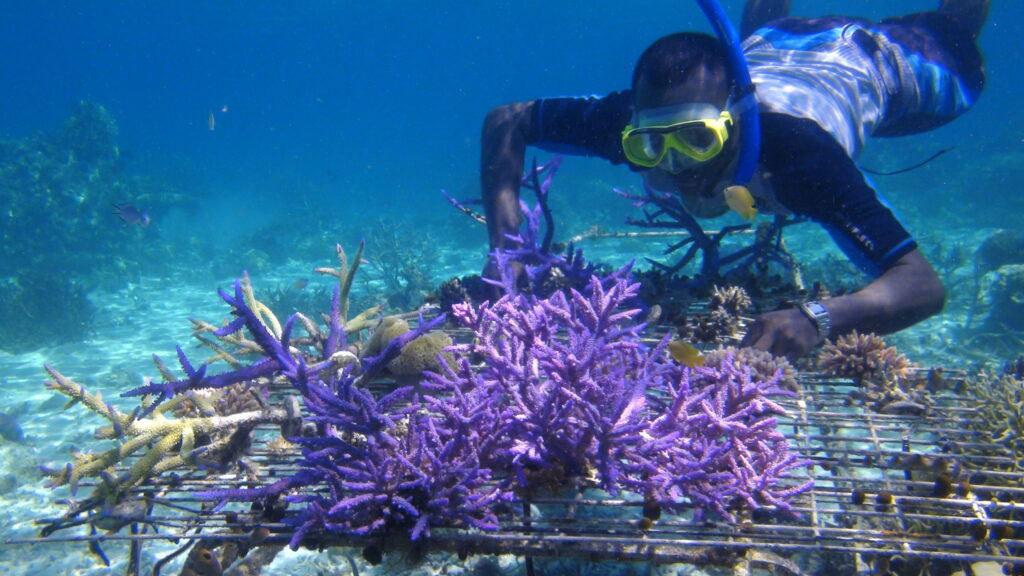
This is a legacy course site from 2020
Maximizing Carbon Emissions Reductions
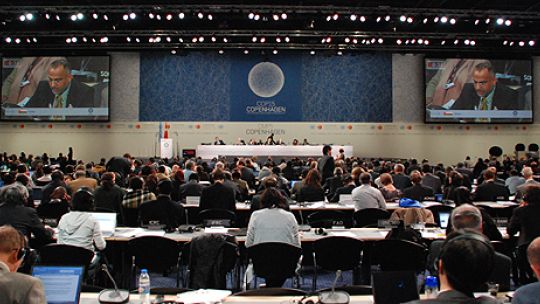
Climate change has threatened human, plant and animal populations around the world. Because it is a global issue, global leadership and global solutions are needed. The international community established a global warming target of 1.5°C in the Paris Agreement. The objective of recent international agreements has been in response to that target. However, further steps must be taken to achieve and surpass the 1.5°C. Rather than simply reduce present levels of greenhouse gas (GHG) emissions, the international community must push for net-zero commitments from all countries around the world and a redesigning of the global economy.
How do we accomplish this?
Different countries and entities have unique strategies to approach carbon emission reductions. Common strategies include:
- Carbon Pricing
“Carbon pricing is an instrument that captures the external costs of greenhouse gas (GHG) emissions—the costs of emissions that the public pays for, such as damage to crops, health care costs from heat waves and droughts, and loss of property from flooding and sea level rise—and ties them to their sources through a price, usually in the form of a price on the carbon dioxide (CO2) emitted.”
–The World Bank, Carbon Pricing Dashboard
- Carbon Offsets
“A carbon offset broadly refers to a reduction in GHG emissions – or an increase in carbon storage (e.g., through land restoration or the planting of trees) – that is used to compensate for emissions that occur elsewhere.”
–Carbon Offset Guide
- Carbon Taxes
“Under a carbon tax, the government sets a price that emitters must pay for each ton of greenhouse gas emissions they emit. Businesses and consumers will take steps, such as switching fuels or adopting new technologies, to reduce their emissions to avoid paying the tax.”
–Center for Climate and Energy Solutions
- Cap and trade
“Cap and trade reduces emissions, such as those from power plants, by setting a limit on pollution and creating a market where emitters can purchase emissions capacity.”
-Environmental Defense Fund
By aggregating such policy strategies, reductions can be maximized. There are three steps towards achieving the economic shift needed to sustainably beat climate change.
Step 1: Legal/Regulatory Strategy
To compel states to research, strategize and deploy a net-zero emissions strategy and to write it into law.
Since writing their net-zero commitments into law, the United Kingdom has secured 29% reductions in carbon emissions. Although they are behind their target, because they created laws to reach said targets, they have made more progress than other signatories of the Paris Agreement. The UK designed a net-zero strategy and then set it into law. Imagine the progress to be made if more countries could be encouraged to do the same!
Step 2: Financial/Technological Strategy
To leverage the funding committed at COP15 and finance a transition to a green global economy.
In 2009 at the Copenhagen Climate Change Conference (COP15), developed countries committed to finance a Clean Development Mechanism (CDM). By signing onto the CDM, developed countries agreed to budget for a transition to a green economy. They even agreed to designate funds to aid developing countries as they renovated their domestic markets.
Financing the transition to a green economy is necessary because until clean energy and technology is widely available, products and services derived from those sources may be more expensive than non-sustainably-sourced products. Additionally, government subsidy will be needed to stabilize companies as they adjust their trajectory to net-zero.
These finances represent the beginning of a shift to more sustainable products and materials. Moving away from economic practices that destroy the planet towards sustainable development strategies is a crucial part of slowing global warming and climate change.
Step 3: Climate Action Strategies
To bring awareness to the public about their contribution to and the status of the carbon emissions reduction effort.
In the United Kingdom, as the government moved towards a greener policies, companies also began to make projections about the financial viability of greener products. It became apparent that investment in these products would cost companies more in the short term. However, market research showed that because of awareness campaigns, the public was willing to accept these costs to purchase products that were better for the environment. This kind of commitment from the public is needed for governments around the world to make the needed investments into a greener future.
The Bottom Line
The world has an urgent decision to make: can global finances, policies and innovations be directed towards slowing climate change? Can this happen despite international challenges such as COVID-19? With the collaboration of nations, international organizations, corporations and the public, there are significant gains to be made towards reducing global warming and climate change.
Sour Oceans
Ocean Acidification Needs Attention
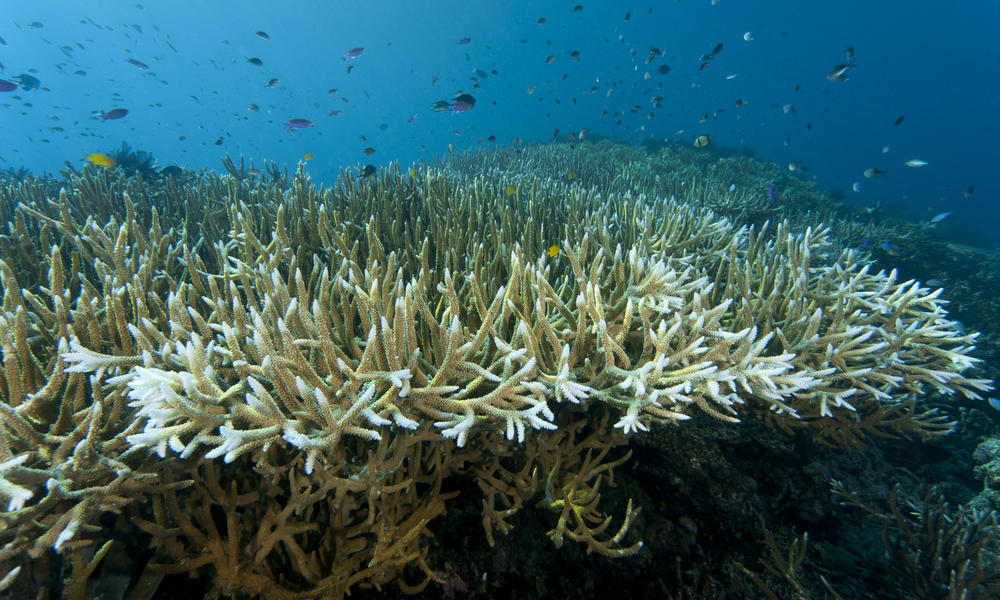
The earth’s oceans are known to be in danger. Plastic pollution, oil spills, and diminishing fish populations are just some of the popular threats people will recognize. One threat, however, poses potentially greater and longer-term damage but is relatively unknown and under-researched — ocean acidification. Acidification is an enormous threat to marine life, ocean and global environmental stability, and communities across the world. The biggest obstacle, though, is we do not know nearly enough to make effective policies.
The oceans play a significant role in the stability of our planet’s climate and systems. Specific to the discussion, the oceans function critically in the carbon cycle by sequestering 50 times more carbon than the atmosphere. Through a variety of paths, such as wind and waves, surface waters absorb carbon dioxide (CO2), which dissolves into the water as carbonic acid and breaks down into bicarbonate and hydrogen ions. Since the start of the industrial revolution, humans have dumped almost 40 gigatons of CO2 into the atmosphere, which has made its way into the oceans. At the current level of oceanic CO2, the pH of surface waters has lowered (grown more acidic) by .1 pH units, which seems like a small number, but represents a 30% increase in acidity since pre-industrial levels.
Ocean acidification poses a significant threat to marine life and communities. All marine life rely on stable ocean chemistry for their security. Changes in ocean acidity have shown to affect the sensory skills, formation, and life span of several species of flora and fauna. Mollusks and other calcifying animals, like crabs and coral, build their shells and skeletons by using the calcium and carbonate from seawater. The process of acidification leaves fewer carbonate ions for these animals to use. Worse still, if the seawater becomes too acidic, it can dissolve the shell or bone. For example, one study placed pteropod shells in seawater with the pH level predicted for the year 2100, and the shells dissolved within 45 days.

Our oceans directly support the economies and communities around the world. For 8% of the world population, the oceans and marine life provide income. And, for the rest of the world, the oceans provide a staple of their diet and form a large part of their cultural identity. Ocean acidification threatens these communities by ruining the future of these economies and cultures. In the United States, the Pacific Northwest population of North Pacific crab, which is the highest revenue fishery in the region, is decreasing significantly due to rising temperatures and acidity. Toxic algae blooms are on the rise and force the closure of nearby fisheries because of the risk to human life. The American economy could experience a $230 million USD loss in the shellfish industry and a $150 billion USD loss in benefits from tourism and recreation.
… read moreIs There Still A Place for A Carbon Tax in U.S. Climate Policy?
A Corrective Tax on Carbon Emissions
In most states dropping a piece of trash on the sidewalk can earn someone a hefty fine. Consumer trash or liquid deposits are considered an environmental hazard to the larger public. Similarly, greenhouse gas emissions generate negative environmental impacts. Impacts from greenhouse gas emissions can include decreasing air quality due to smog and air pollution, which can contribute to increased public health risks from respiratory illnesses. More broadly, greenhouse gas emissions trap heat in the atmosphere, which has created a global warming effect that is changing the climate in devastating and lasting ways.
In the U.S., the biggest emitters of greenhouse gas emissions is the transportation sector, closely followed by the electricity sector. Electricity in the U.S. is moving toward cleaner energy sources, but according to the Environmental Protection Agency, 62% of the nation’s electricity still comes from carbon-based fuel sources such as coal, oil, and natural gas. Companies emitting large quantities of emissions profit off the burning of fossil fuels but seldom feel the cost burdens of the negative impacts.
How Would It Work?
In December of 2016, the Congressional Budget Office (CBO) put out a report – with options on reducing the federal budget deficit – detailing how a carbon tax might operate in the United States. CBO proposed a carbon tax of $25 per metric ton on most, but not all, emissions generated by a variety of sectors including electricity, manufacturing, and transportation. The tax would increase yearly by 2%. CBO predicted the first ten years of a carbon tax would see $977 billion accrued in tax revenue for the federal government and a 9% reduction in emissions across all participating sectors. Taxing carbon can be a way to not only improve atmospheric air quality but also to generate revenue towards additional climate mitigation strategies.

Additionally, carbon taxes can be structured in a way that builds flexibility for markets to have autonomy over how they choose to reduce emissions – the onus doesn’t need to be on curbing productivity. Emissions reduction can take place through lower emissions intensity, reductions in energy demand, or through capture and storage. A carbon tax could also standardize emissions monitoring and data collection through a federal regulatory body.
And finally, creating a U.S. tax on carbon emissions would be feeding into a global framework. As shown by the World Bank’s Carbon Pricing Dashboard, more than 70 national and subnational jurisdictions have carbon pricing policies. A carbon price enacted in one of the world’s richest economies can act as a price signal for the global economy to move polluting industries and their associated supply chains away from carbon-based fuel sources.
How Might It Fail?
A carbon tax can be an effective environmental and financial tool. But where and how can it go wrong?
- A global issue – Climate change is problem created and felt globally, and for true effectiveness, so must the solution. A U.S. carbon tax might help mitigate the greenhouse gas emission of one o the leading polluting countries in the world, other high emitting countries may not be inclined to follow.
- Political resistance – Fossil fuel companies would commonly weaponize these policies politically by indicating that the costs of these taxes would be felt most by consumers. Additionally, increasing taxes of any kind is rarely politically palatable.
- The price is high – In 2018, the United Nation’s climate science panel indicated a carbon tax would need to be at least $135 per metric ton to stop global temperature rise above 1.5 degrees Celsius. To be truly effective at reducing large amounts of emissions, the price needs to be much higher than the average carbon tax.
Only One of the Tools in the Toolbox
The truth is, while a carbon tax might hit at a root of the climate crisis – polluters unwilling motivated to significantly reduce emissions – the global community is out of time and needs bold dramatic action to combat climate change. And unfortunately, as the effects of climate change advance in severity, there is a grooming disconnect between the dangers of greenhouse gas emissions and the effects of carbon pricing.
While a carbon tax can lend credibility to the U.S.’s role as a climate leader, especially among those like Canada, the EU, and Mexico, it shouldn’t be the centerpiece of the federal climate policy legislation. In an ideal world, the highest polluting countries would work together to designate mutually agreed upon carbon tax that would start low but steadily increase and make it costly through trade sanctions for high polluting countries do not have a carbon tax. A carbon tax can instead provide a backstop for other public and private mitigation strategies, such as a federal renewable energy standard.
Offshore Drilling: Under-Reported and More Impactful than You Think
Spillage and Under-reporting
Everyone remembers how crazy it was to hear about the BP oil spill and the sheer extent of damage caused to marine life and habitats. Pictures and videos of volunteers washing the sludge off of seabirds and marine mammals could be seen everywhere. It was close to home, and it really began to bring public attention in the US to the devastation that these accidents could cause. A nation where hundreds of miles are occupied by refineries, pipelines, and rigs. But why did it take this long for people to notice, or even care? I mean, even without oil spills, according to the US Department of Energy, the amount of petroleum that ends up in US waters averages to about 1.3 million gallons per year, with the potential to double in the case of an oil spill. That is, if all the dumps were reported.

Back in 2004, Hurricane Ivan knocked loose a lip of sediment on the continental shelf, which resulted in an underwater avalanche that knocked down an oil platform owned by Tyler Energy, severing its connection with more than a dozen wellheads in the Gulf of Mexico. Instead of going public with the information about the massive oil spill, however, the Louisiana-based oil company decided to secretly work on recapping the well, unsuccessfully, for six years. Due to lack of immediate impact to local communities and no loss of human life, Tyler Energy and the government continued to keep it under the table until in 2010, when researchers were doing a flyover to measure the extent of the damage of the 4 million gallon BP Deepwater Horizon oil spill. It wasn’t until 2019 that the United States Coast Guard, in coordination with a private contractor, were able to cap the well after 15 years of spillage at 300-700 gallons of oil a day.
Under-reporting has been a prevalent issue in the Gulf, as there are fines for not reporting leaks, but none for under-reporting. Oil companies are incentivized to keep the extent of leaks and spills secret, reporting numbers that are sure not to garner too much unwanted attention from the public or environmental groups. COVID has only amplified this issue, after the legislation passed by the Trump administration early last year. Last year during the beginnings of the pandemic, the Trump administration declared that it was no longer mandatory to comply with monitoring and reporting of pollution, so the reporting for oil spills and other environmental pollution for the year of 2020 is scattered, and the actual extent of environmental damages is unknown.
More than just Oil Spills
Offshore drilling holds more risk than just oil spills. As explained by the Surfrider Foundation, offshore drilling comes with a myriad of environmental impacts, causing far more damage than oil spills and are much less visible.
Oil Exploration through seismic surveys, or commonly referred to as ‘air gun blasting’ are conducted to find the location and parameters of potential oil reserves. These ‘blasts’ of high decibel impulses can harm or kill marine life, deafen marine mammals, disrupt migratory patterns, and have also been implicated in whale beaching and stranding. Drilling muds, the combination of polluted water and drilling chemicals released from drilling and processing oil, contain high concentrations of metals and are toxic to marine life, but are dumped back into the ocean if measured to be under a certain level of toxicity. Air quality is also degraded as a result of offshore drilling, as volatile organic compounds are released into the air from oil platforms, leading to water quality deterioration, smog, and more.
Onshore, environmental impacts are felt too, as extensive infrastructure is needed to support the refining and transport of oil on land. Pipelines, refineries, and production facilities all need to be operated to support offshore drilling facilities. The space and resources needed to operate these facilities takes away from the environmental resources of local wildlife and can from local tourism associated with the coast, as shorefront property is utilized to facilitate the refining and transportation of oil. The on-land transportation of oil also has its own risks, as seen with the Keystone Pipeline, which burst twice in two years and on its second spill leaked over 400,000 gallons of crude oil into a North Dakota wetlands in 2019.
/https://public-media.si-cdn.com/filer/f3/a6/f3a6fe69-8562-490e-82b8-1f47d7440842/ap_17322182296131.jpg)
What’s in the Future for Offshore Drilling?
Despite the negative tone of this article, the future is looking cautiously optimistic. Last week, New Jersey Rep. Frank Pallone announced his intention to move forward with filing for a bill that would ban offshore drilling in the Atlantic permanently. This legislation comes as President Joe Biden pushes the American Jobs Plan, which aims to rebuild America’s energy infrastructure, supporting the production of clean energy while investing in the cleanup of old and abandoned oil and gas wells and mines. These proposals come as a welcome change of pace for environmentalists and ocean conservationists, after the Trump administration’s proposal to open oil and gas deposits off the coastlines of the Atlantic, Pacific and Arctic oceans in 2018.

Farther south of America’s borders, however, plays out a different story. BPC, Bahamas Petroleum Company, is focusing on developing oil reserves off the coasts of Trinidad and Tobago and Suriname, moving in alongside the oil giants ExxonMobil and Total after the latter discovered large reserves off the coast of Suriname earlier this year. This decision only comes after 48 days of exploratory drilling in the Bahamas, when the company determined that the reserves were not commercially viable and that the site would be sealed and abandoned. The Our Islands, Our Future campaign has been vehemently opposed to these operations, and have taken the government and BPC to court for the non-transparent granting of permits late last year. Damages caused by the initial drilling are yet to be determined if they fall under insurance provided by the company, and leaders of the campaign are fighting to prevent any more action taken by BPC in the Bahamas. You can sign their petition here to help fight for the permanent ban of all fossil fuel exploration in the Bahamas.
Though under-reporting and the adverse environmental issues of offshore drilling remain an issue, current legislation to fight these industries seems promising, and the quicker that America can become less reliant on fossil fuels, the faster these operations will become less prevalent.


